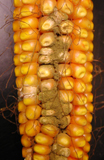|
|
Vol.
27 No. 4
July-August 2005
XI International IUPAC Symposium on Mycotoxins and Phycotoxins
by Douglas L. Park
The series of International Symposia on Mycotoxins and Phycotoxins, initiated by the IUPAC Food Chemistry Commission, began in Kungalv, Sweden, in 1973. Since then, nine symposia have been held in Pulawy, Poland; Paris, France; Lausanne, Switzerland; Vienna, Austria; Pretoria, South Africa; Tokyo, Japan; Mexico City, Mexico; Rome, Italy; and Guaruj, Brazil. The symposia have become the principal international interdisciplinary meetings on mycotoxins and phycotoxins.
The 11th symposium
was held in May 2004 at the Natcher Center of the National
Institutes of Health in Bethesda, Maryland, USA. Over 300
participants from 41 countries were present for 63 oral presentations
(52 presentations on mycotoxins and 11 on phycotoxins) by
internationally recognized speakers. In addition, 127 posters
were on display (116 on mycotoxins and 11 on phycotoxins).
The focus of the oral sessions included Ecology and Biodynamics,
Toxicology and Health Effects, Prevalence of Known and New
Toxins, Advances in Analytical Methods, and Advances in Preventative
Intervention.
Keynote speaker Maya Pineiro (FAO, Italy), speaking for Ezzeddine Boutrif (FAO), addressed the importance of mycotoxins and phycotoxins on the global perception of food safety. Key topics at the symposium included regulations, risk assessment, and applications of methodologies for economically challenged regions.
A number of presentations provided insight and cutting-edge concepts, including “New Technologies for Predicting Risk: the Impact of the Advent of the ‘Omics’,” by Daniel Casciano from the National Center for Toxicology Research, Food and Drug Administration, USA. During his talk, he introduced the term “systeomic” to the audience and indicated that this new approach would result in the reduction in animal use and resolve the value of non-invasive techniques in animal and human research, including mycotoxins and phycotoxins.
Other presentations focused on reducing fungal infections and mycotoxin levels in crop plants in the field and in storage, as well as the establishment of regulations, as presented by Walter F.O. Marasas, Medical Research Council of South Africa, and Hans van Egmond, National Institute of Public Health and the Environment, Netherlands. Felicia Wu (University of Pittsburgh, PA, USA) pointed out that the implications of both health and economic outcomes are important for policymakers to consider when developing international standards for mycotoxins. In the area of phycotoxins, Sherwood Hall (U.S. FDA) offered an insightful presentation indicating that optimizing seafood safety requires finding a balancing point between detection methods that may be more accurate or sensitive and those that are simpler and faster that would be more likely to be reliably performed at an adequate frequency, given the temporal and spatial density required for effective monitoring.
During the symposium, an announcement was made concerning a possible significant aflatoxicosis poisoning outbreak that was unfolding in Kenya due to aflatoxin contaminated maize. In the subsequent weeks, it was found that over 300 cases of poisoning were reported, with 125 deaths.
 |
| Aflatoxins are produced by different species of Aspergillus, particularly flavus and parasiticus, as well as members of the Genera Penicillium and Rhizopus. Strains of Aspergillus flavus and parasiticus produce mycotoxins under favorable conditions. Aflatoxins can contaminate corn, cereals, sorghum, peanuts, and other oil-seed crops. |
One of the reasons for rotating this meeting to different locations worldwide was to allow for local issues to be addressed in the area of mycotoxins and phycotoxins. This is why it was decided during the meeting that the XII International IUPAC Symposium on Mycotoxins and Phycotox-ins will be held in Istanbul, Turkey, in 2007. There has not been a symposium of this magnitude in the Middle East, and the problems of mycotoxins and phycotoxins in this economically challenged area of the world can be addressed more adequately once the meeting is held. For more information, please contact Hamide Senyuva <[email protected]>.
During the last day of the symposium, a follow-up session was held for the participants of the 2002 International Workshop on Mycotoxins. Ten presentations were made by scientists from economically challenged nations that previously participated in the workshop (three from Latin America, three from Africa, three from Asia, and one from Europe). They described significant progress in the establishment of training opportunities, as well as the practical application of mycotoxin management programs.
The editorial committee of the symposium is preparing the proceedings, with a target date for publication in the second half of 2005. For more information, please contact Dr. Henry Njapau <[email protected]> regarding the book of abstracts or the proceedings. Douglas L. Park <[email protected]>, chairman of the organizing committee, is the director of the Division of Natural Products, Center for Food Safety and Applied Nutrition, FDA, USA. He is a member of several international organizations in the area of mycotoxins.
Page
last modified 17 June 2005.
Copyright © 2003-2005 International Union of Pure and
Applied Chemistry.
Questions regarding the website, please contact [email protected]
|